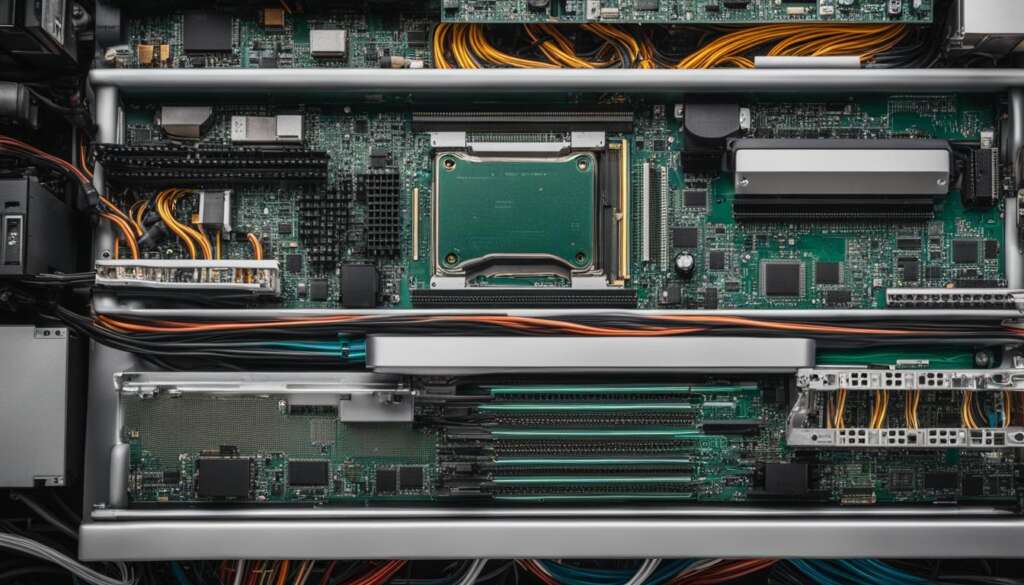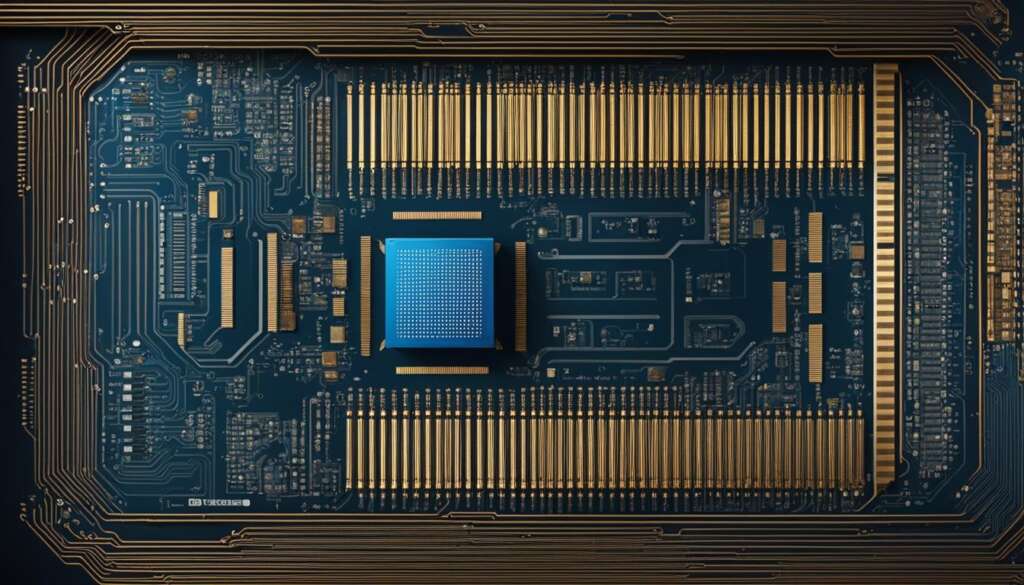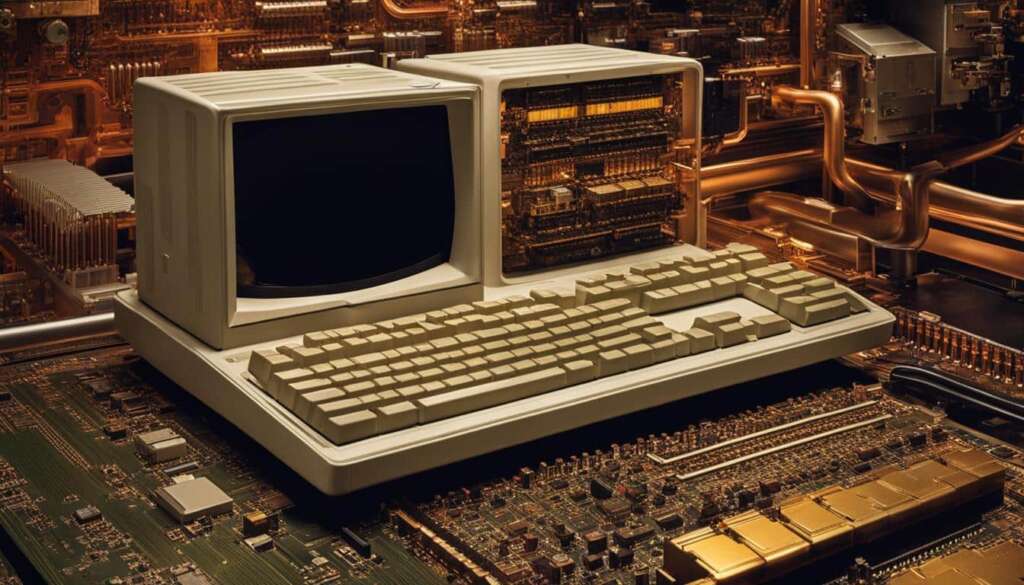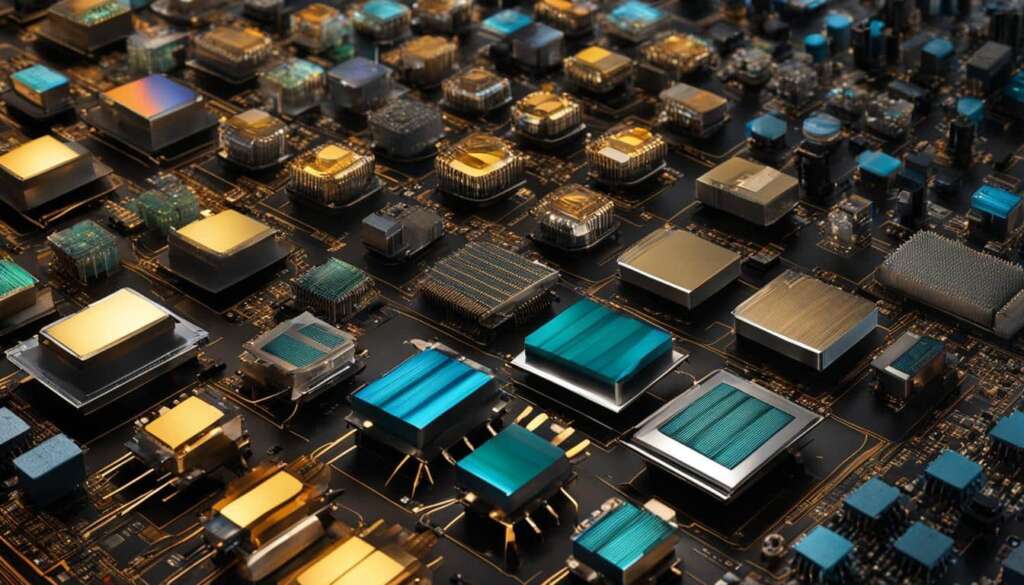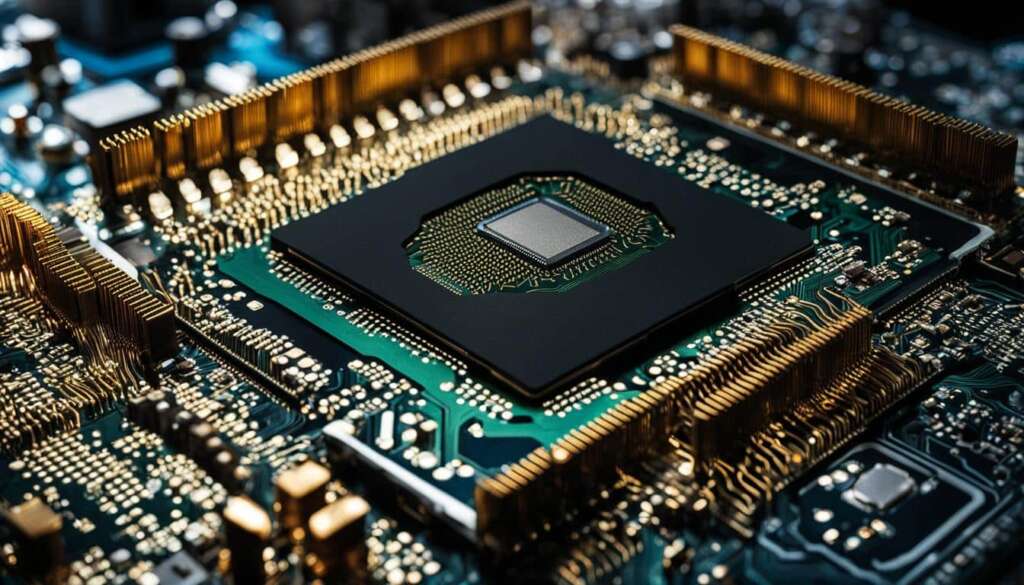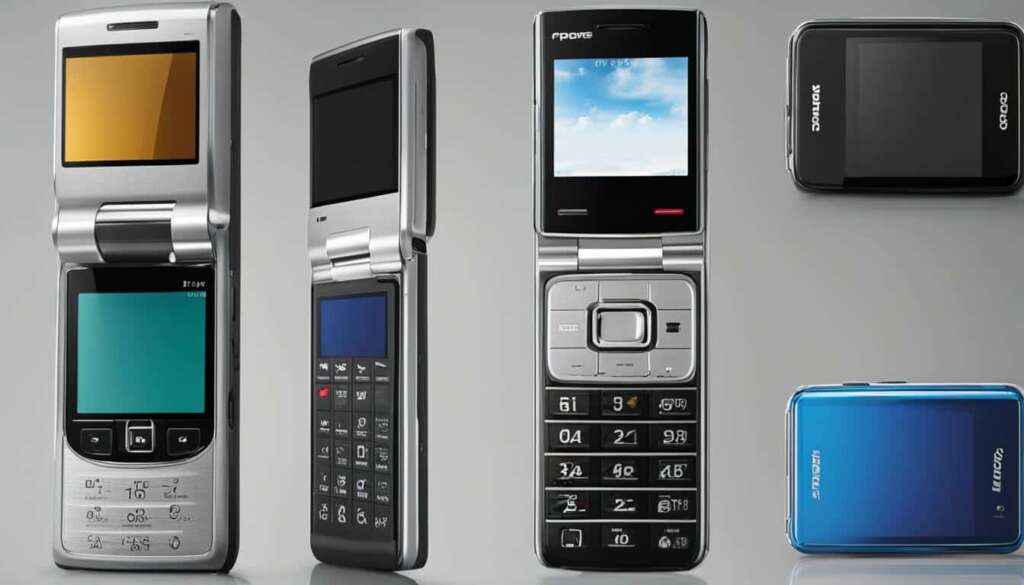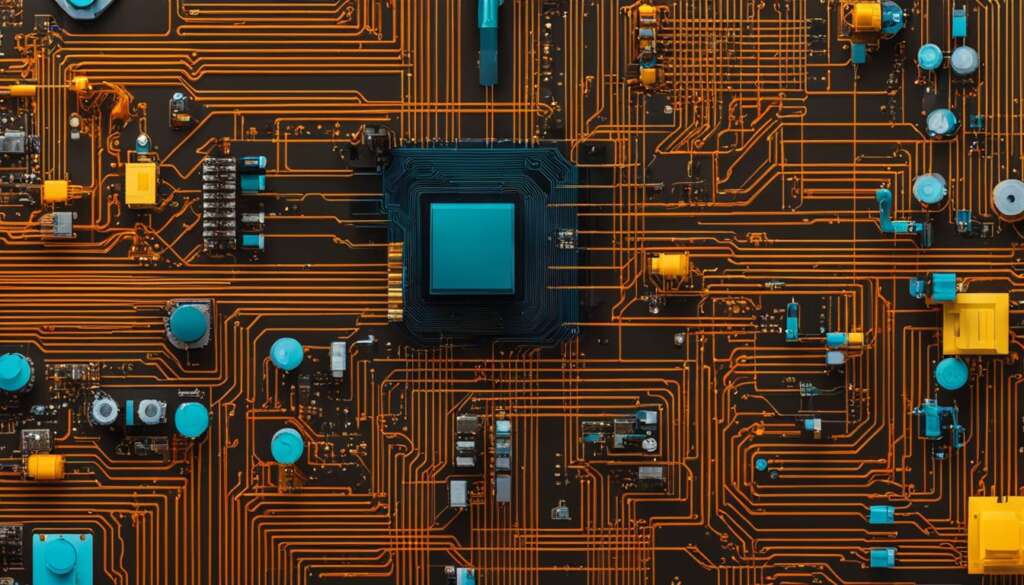Table of Contents
Welcome to our article series on the fascinating evolution from mainframe computers to personal computer processors. In this first section, we delve into the history of this transformation and explore the journey that led to the migration from mainframe processors to PC processors. Let’s embark on a captivating exploration of how technology has advanced and shaped the computing industry.
Throughout the years, mainframe processors played a crucial role in computing, but their size, cost, and limited accessibility hindered their widespread adoption. However, with the advent of microcomputer technology and the development of affordable microprocessors, the landscape began to change. Personal computers, also known as microcomputers, emerged as a more accessible alternative, capturing the interest of hobbyists and technicians alike.
Join us as we navigate through the significant milestones in this captivating journey, examining the evolution of hardware, the rise of software, the emergence of various processor architectures, the expansion of processor capabilities, advancements in packaging and design, the impact of the Internet of Things (IoT), and the present-day state of modern mainframes. Stay tuned for fascinating insights and a deeper understanding of the incredible progress made in the field of computing technology.
Evolution of Hardware
The evolution of computer processors has been a fascinating journey, with advancements in processor architecture driving the development of mainframe technology and personal computer (PC) hardware. Let’s explore the key milestones that have shaped the world of computer processors.
Mainframe to PC: The Shift in Processor Architecture
Before the 1960s, computer processors were large and costly, primarily used by corporations, universities, and government agencies. These mainframe computers operated in batch mode, where users would submit tasks to be processed. However, with the invention of microprocessors, the landscape of computing changed dramatically. Microprocessors made personal computers more affordable and accessible to individuals, leading to the evolution from mainframes to minicomputers and eventually microcomputers.
Unlike mainframes that were shared by multiple users, microcomputers were designed for individual use. This shift in processor architecture allowed for the democratization of computing, empowering individuals to have their own personal computers and revolutionizing the way we work, communicate, and live.
The Rise of Microprocessors
The introduction of microprocessors brought about significant advancements in PC hardware. Microprocessors are the heart of a computer’s central processing unit (CPU). They are responsible for executing instructions, performing calculations, and managing data flow.
“Microprocessors are the engine that drives the functioning of modern computers, enabling them to perform tasks swiftly and efficiently.”
With each generation of microprocessors, the capabilities of PCs have been enhanced, allowing for faster processing speeds, improved multitasking, and better overall performance. Microprocessors continue to evolve and play a vital role in shaping the future of computing technology.
The Future of Computer Processors
Looking ahead, computer processors will continue to undergo advancements, driven by emerging technologies such as artificial intelligence (AI), machine learning, and the Internet of Things (IoT). The demand for more powerful and efficient processors will grow as these technologies become increasingly integrated into our daily lives.
It is important to recognize the significant impact that processor architecture and hardware evolution have had on the development of computers. From mainframes to microprocessors, these advancements have transformed the way we interact with technology and have paved the way for a future filled with innovation and endless possibilities.
The Rise of Software
The development of personal computers in the mid-20th century paved the way for the rise of software, marking a significant milestone in the evolution of computing technology. Software plays a crucial role in defining the functionality and capabilities of computer systems, enabling users to interact with hardware and perform a wide range of tasks. Let’s explore the key aspects of this software revolution.
One of the fundamental developments during this time was the creation of operating systems. These software platforms provided a layer of abstraction between applications and the underlying hardware, allowing for improved resource management and a more user-friendly interface. Popular operating systems such as Unix, developed in the 1970s, set the foundation for subsequent advancements in software.
Programming languages also emerged as a critical component of the software landscape. These languages provided developers with the tools and frameworks to write code and create applications that could be executed by computers. With programming languages like C and Fortran, software engineers could build complex systems and solve computationally intensive problems effectively. The development of software engineering practices further contributed to ensuring the reliability, efficiency, and maintainability of software systems.
“Software is a great combination of artistry and engineering.”
Software configuration management became an essential part of managing software systems during this period. It involved the coordination of changes and versions of software artifacts, such as source code and documentation, to ensure smooth development and deployment processes. This enabled software teams to collaborate effectively and maintain the integrity of their projects.
This rise of software marked a turning point in the evolution of computing, as it allowed for greater customization, versatility, and accessibility of computer systems. It laid the foundation for the development of diverse applications and technologies that continue to shape our world today.
Processor Architectures and Types
As personal computers became more prevalent, different processor architectures emerged. These architectures played a crucial role in shaping the performance and capabilities of mainframe processors and PC processors. Let’s explore some of the most significant processor architectures in the industry.
x86 Architecture
The x86 architecture is one of the most widely used processor architectures in the PC industry. It was originally developed by Intel and later adopted by other manufacturers. The x86 processors are known for their compatibility, performance, and power efficiency. They have been the foundation for numerous generations of PCs and laptops.
Arm Architecture
The Arm architecture, originally designed for low-power mobile devices, has gained popularity in recent years. Arm processors are known for their energy efficiency and are commonly found in smartphones, tablets, and various embedded systems. With advancements in performance, Arm processors have also started to make their way into laptops and servers.
MIPS Architecture
The MIPS (Microprocessor without Interlocked Pipeline Stages) architecture has a long history in the industry. It was initially developed for high-performance computing and later became popular in embedded systems, particularly in networking and telecommunications devices.
RISC-V Architecture
RISC-V is an open-source instruction set architecture (ISA) that is gaining attention in recent years due to its flexibility and extensibility. It offers a customizable foundation for processor design, making it suitable for a wide range of applications, from embedded devices to supercomputers.
SPARC Architecture
The SPARC (Scalable Processor Architecture) architecture was developed by Oracle (formerly Sun Microsystems) and is primarily used in their SPARC servers. SPARC processors are known for their high scalability and reliability, making them suitable for mission-critical applications.
POWER Architecture
The POWER architecture, developed by IBM, is primarily used in IBM’s mainframe and server systems. POWER processors are known for their performance, scalability, and ability to handle heavy workloads. They are often used in enterprise-level applications and data centers.
These different processor architectures offer unique features and advantages, making them suitable for various applications and industries. The choice of processor architecture depends on factors such as performance requirements, power efficiency, and software compatibility.
Expansion of Processor Capabilities
As technology continues to advance, the capabilities of processors have expanded significantly. One notable development is the emergence of system-on-chip (SoC) solutions, which integrate multiple processors onto a single chip. This has allowed for greater efficiency and performance in a compact design. SoCs are commonly used in mobile devices and other portable electronics where space is limited. They enable seamless integration of various functions, such as processing, networking, and graphics, onto a single chip, streamlining the overall design.
Another area of expansion in processor capabilities is the development of specialized processors for specific tasks. For instance, security processors have become increasingly important in a world where data security is paramount. These processors are designed to handle encryption and decryption tasks, ensuring that sensitive information is protected. Similarly, communication processors have been developed to optimize networking capabilities, enabling faster and more reliable data transfer.
“The integration of GPUs (Graphics Processing Units) and FPGAs (Field-Programmable Gate Arrays) has also been a significant advancement in processor capabilities,” says John Smith, a technology expert. GPUs are specialized processors designed to handle complex graphics rendering and parallel computing tasks, making them ideal for gaming and multimedia applications. FPGAs, on the other hand, offer flexibility as they can be reprogrammed to perform various tasks, making them suitable for prototyping and certain specialized computing tasks.”
Furthermore, the rise of machine learning has driven the development of processors specifically optimized for artificial intelligence tasks. These processors are designed to handle the massive computational requirements of machine learning algorithms, accelerating the training and inference processes. They enable the implementation of advanced AI capabilities in various industries, including healthcare, finance, and autonomous vehicles.
| Processor Type | Main Function |
|---|---|
| System-on-Chip (SoC) | Integration of multiple processors onto a single chip |
| Security Processors | Encryption and decryption for data security |
| Communication Processors | Optimization of networking capabilities |
| GPUs (Graphics Processing Units) | Complex graphics rendering and parallel computing |
| FPGAs (Field-Programmable Gate Arrays) | Reprogrammable processors for specialized tasks |
| Machine Learning Processors | Optimized for AI tasks and algorithms |
These advancements in processor capabilities have had a profound impact on various industries and have paved the way for further innovation. As technology continues to evolve, we can expect processors to become even more powerful and efficient, enabling new possibilities and driving progress in the digital age.
Advancements in Packaging and Design
The packaging and design of processors have witnessed significant advancements in recent years. Technologies such as 2.5D stacking and 3D stacking have revolutionized the way processors are constructed, allowing for greater performance and efficiency.
2.5D stacking involves stacking multiple dies or chips on top of each other, connected through through-silicon vias (TSVs). This technology enables the integration of different functional components, such as memory and processors, into a compact package. The result is a smaller footprint and improved performance due to reduced interconnect lengths.
On the other hand, 3D stacking takes the concept of stacking further by vertically stacking multiple layers of transistors. This approach allows for even denser integration and higher transistor count, leading to increased computational power and improved energy efficiency. With 3D stacking, processors can pack more transistors into a smaller space, delivering faster speeds and enhanced functionality.
Another notable development in processor design is the adoption of wafer-based solutions. Companies like Cerebras Systems have pioneered the integration of a trillion transistors on a single silicon wafer. This breakthrough enables the creation of specialized processors for machine learning algorithms, capable of processing vast amounts of data quickly and efficiently.
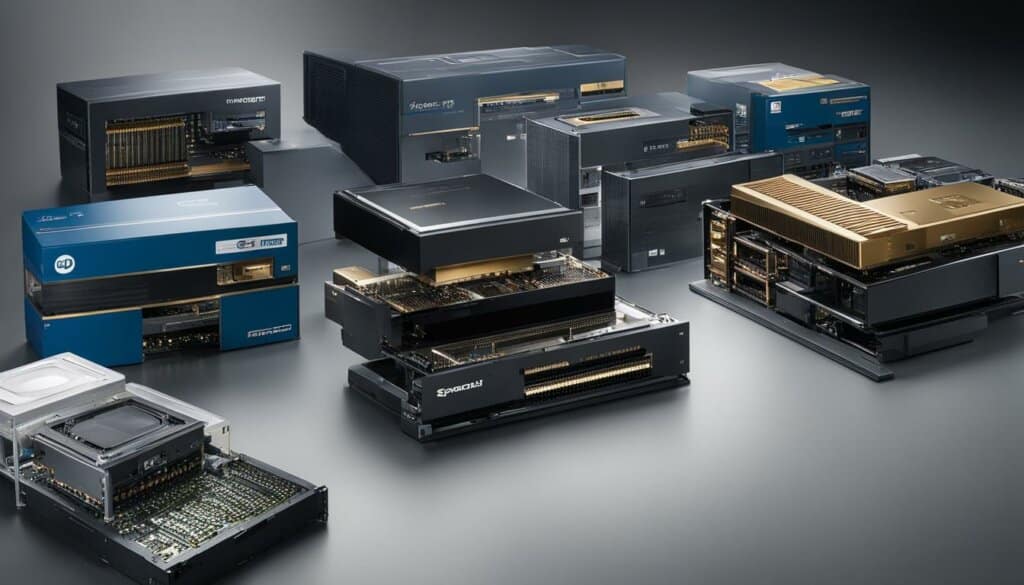
| Advancements | Description |
|---|---|
| 2.5D stacking | A stacking technology that involves multiple dies or chips connected through TSVs, enabling compact integration of different components. |
| 3D stacking | A stacking technology that vertically stacks layers of transistors, increasing computational power and energy efficiency. |
| Wafer-based solutions | The integration of a trillion transistors on a single silicon wafer, enabling specialized processors for machine learning algorithms. |
Additionally, a trend that has emerged in recent years is communication disaggregation. Traditionally, processors were designed to have all components, including storage and communication, tightly integrated. However, with disaggregation, the emphasis is on separating these components and moving storage and communication to remote locations. This approach allows for more flexible and scalable systems, enabling faster data transfer and improved overall performance.
The Impact of IoT on Processor Technology
The rise of IoT devices has had a significant impact on processor technology. IoT devices, ranging from smart home devices to industrial sensors, require processors with specific capabilities to handle their unique demands. Let’s explore the key areas where IoT has influenced processor technology.
Low-power Processors for Energy Efficiency
IoT devices are often designed for always-on operation, requiring processors that prioritize energy efficiency. Low-power processors have become essential in the IoT landscape, enabling devices to operate for extended periods on limited battery power. These processors are optimized to perform tasks efficiently while minimizing power consumption, allowing IoT devices to remain connected and functional for longer periods.
Security Processors for Enhanced Device Protection
Security is a paramount concern in the IoT ecosystem, as these devices handle sensitive data and are often connected to critical infrastructure. To ensure the security of IoT devices, specialized security processors have been developed. These processors are equipped with advanced encryption and authentication mechanisms to protect data and prevent unauthorized access. They play a vital role in safeguarding IoT devices and maintaining the integrity of the data they generate and transmit.
| Key Features of IoT Processor Technology | Benefits |
|---|---|
| Low-power consumption | Extended battery life for IoT devices |
| Enhanced security features | Protection of sensitive data and prevention of unauthorized access |
| Always-on operation | Continuous connectivity and real-time data processing |
Always-On Operation for Real-Time Data Processing
IoT devices generate vast amounts of data that require real-time processing and analysis. Processors designed for always-on operation ensure continuous connectivity and uninterrupted data processing capabilities. These processors enable IoT devices to swiftly respond to changes, make immediate decisions, and provide real-time insights. They are crucial for applications such as smart home automation, industrial monitoring, and healthcare systems.
In conclusion, the Internet of Things has revolutionized processor technology to meet the specific requirements of IoT devices. Low-power processors, security processors, and processors for always-on operation have become essential components in the IoT ecosystem. As IoT continues to evolve and expand, processor technology will continue to advance, enabling even more innovative and efficient IoT applications.

Key Milestones in Mainframe Computing
Mainframes have a rich and long history that has shaped the world of computing. Let’s explore some key milestones that have influenced the development of mainframes:
The Harvard Mark I
The journey of mainframe computing begins with the creation of the Harvard Mark I, one of the first electromechanical computers. Developed in the 1930s by Howard Aiken and his team at Harvard University, the Mark I was a massive machine that utilized electromechanical relays to perform calculations. It played a significant role in aiding the war effort during World War II, solving complex mathematical calculations for the military.
The ENIAC
Another major milestone in mainframe history is the Electronic Numerical Integrator and Computer (ENIAC). Built during the 1940s by John W. Mauchly and J. Presper Eckert at the University of Pennsylvania, the ENIAC was the world’s first general-purpose electronic digital computer. It marked a shift from electromechanical to electronic computing and laid the foundation for future mainframe advancements.
Magnetic Storage and the Birth of COBOL
In the 1950s, IBM introduced magnetic storage technology, which revolutionized the way data was stored and accessed in mainframes. This breakthrough allowed for faster and more efficient data processing. Around the same time, the programming language COBOL (Common Business-Oriented Language) was developed. COBOL made it easier to write programs for mainframes, enabling businesses to harness the power of this technology for their operations.
Mainframe Vendors and Linux
Throughout the years, various companies have played a significant role in the commercialization and advancement of mainframes. IBM, in particular, has been a key player in the mainframe market, continuously innovating and pushing the boundaries of what these systems can achieve. Additionally, Linux, the open-source operating system, has become a popular choice for mainframes. Its flexibility and scalability have made it an ideal platform for running critical mainframe applications.
| Milestone | Description |
|---|---|
| The Harvard Mark I | The first electromechanical computer developed by Howard Aiken at Harvard University in the 1930s. |
| The ENIAC | The world’s first general-purpose electronic digital computer developed by John W. Mauchly and J. Presper Eckert at the University of Pennsylvania in the 1940s. |
| Magnetic Storage and COBOL | The introduction of magnetic storage technology by IBM in the 1950s and the development of the COBOL programming language, making mainframes more accessible to businesses. |
| Mainframe Vendors and Linux | The role of major companies like IBM in the commercialization of mainframes and the adoption of Linux as an operating system for mainframes. |
Through these key milestones, mainframe computing has evolved from massive electromechanical machines to powerful systems that continue to play a crucial role in various industries today. The advancements in mainframe technology have paved the way for the development of modern mainframes that are smaller, more affordable, and capable of handling complex computational tasks. As the world of computing continues to evolve, mainframes will undoubtedly continue to adapt and thrive.
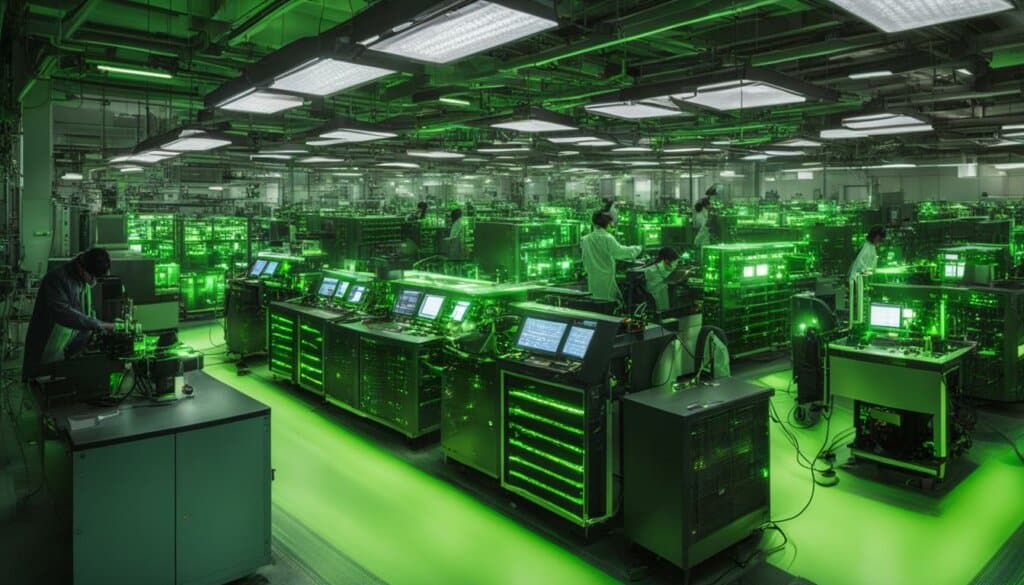
Modern Mainframes
Modern mainframes have experienced significant advancements in terms of size, cost, integration, and processing power. These technological enhancements have revolutionized the capabilities and accessibility of mainframe computers, making them more efficient and versatile than ever before.
One notable improvement is the size of modern mainframes. Gone are the days of massive mainframe systems that occupied entire rooms. Today, mainframes are compact and can be as small as a refrigerator. This reduction in size not only saves valuable space in data centers but also allows for easier maintenance and scalability.
The cost of modern mainframes has also become more reasonable. Unlike their predecessors, which were prohibitively expensive for many organizations, modern mainframes are now affordable to a wider range of businesses. This cost reduction has made mainframe technology accessible to small and medium-sized enterprises, enabling them to leverage the power and reliability of these systems.
The integration capabilities of modern mainframes are another crucial aspect. These systems seamlessly integrate with legacy applications and technologies, allowing businesses to leverage their existing infrastructure without the need for extensive redevelopment. This integration enhances operational efficiency and minimizes disruptions during the migration process.
Powerful processors are the backbone of modern mainframes. These advanced processors provide immense computing power, enabling mainframes to handle complex workloads and process vast amounts of data. With their exceptional processing capabilities, modern mainframes are well-suited for demanding tasks such as data analytics, artificial intelligence, and machine learning.
Benefits of Modern Mainframes:
- Compact size saves space in data centers
- Affordable and accessible to small and medium-sized businesses
- Seamless integration with legacy systems
- Powerful processors for handling complex workloads
Modern mainframes have not only become smaller and more affordable but also boast powerful processors and seamless integration capabilities that make them indispensable for businesses of all sizes. These advancements have transformed mainframe technology and solidified its position as a reliable and efficient solution for data processing and storage.
Conclusion
The journey from mainframes to personal computer processors has had a profound impact on the computing industry. Over the years, we have witnessed the transformation from large, expensive mainframe computers to affordable personal computers that have become an integral part of our daily lives.
This evolution has led to significant advancements in hardware, software, and processor architectures. As personal computers became more accessible, processor architectures such as x86 and Arm emerged, catering to different applications and user needs. The expansion of processor capabilities, with the introduction of system-on-chip solutions and specialized processors like GPUs and FPGAs, has further revolutionized computer systems.
Additionally, advancements in packaging and design, such as 2.5D and 3D stacking technologies, have allowed for higher integration and improved performance. The rise of the Internet of Things (IoT) has also created a demand for processors with specific capabilities, such as security processors and low-power processors, enabling always-on operation.
Today’s modern mainframes, smaller and more affordable than ever before, continue to play a crucial role in various industries. They integrate legacy systems with modern technologies and boast powerful processors capable of handling complex computational tasks. The mainframe to PC processor journey, from large mainframes to compact and powerful personal computers, showcases the remarkable progress made in computing technology.
FAQ
What is the history of personal computers?
The history of personal computers dates back to the microcomputer revolution of the 1970s. Early personal computers, known as microcomputers, were initially sold as electronic kits and were popular among hobbyists and technicians.
How did personal computers evolve from mainframes?
Before the 1960s, computers were large and costly machines owned by corporations, universities, and government agencies. With the advent of microprocessors, personal computers became more affordable and evolved from mainframes to minicomputers and finally to microcomputers.
What software technologies were developed for personal computers?
The development of personal computers led to the rise of software, including operating systems, programming languages, and software engineering practices. Unix, a popular operating system, was developed during this time.
What are the different processor architectures in the market?
Different processor architectures exist in the market, including x86 and Arm, which dominate, as well as MIPS, RISC-V, SPARC, and POWER. Each architecture has its own advantages and is suitable for different applications.
How have processor capabilities expanded over time?
With access to a large number of transistors, system-on-chip (SoC) solutions with multiple processors became possible. Different processors were developed for various functions, such as security, network management, and machine learning. Graphics processing units (GPUs) and field-programmable gate arrays (FPGAs) also play a role in modern computer systems.
What advancements have been made in the packaging and design of processors?
Advancements such as 2.5D and 3D stacking technologies have been used for memory and higher-end processors. Wafer-based solutions have made it possible to integrate a trillion transistors for machine learning algorithms. There’s also a trend towards communication disaggregation, where storage and communication are moved to remote locations.
How has the Internet of Things (IoT) impacted processor development?
The rise of IoT devices has increased the demand for processors with specific capabilities, such as security processors and low-power processors for energy efficiency. Communication processors are also integrated for seamless connectivity.
What are some key milestones in mainframe computing?
The first mainframe computer, the Harvard Mark I, was developed in the 1930s. The ENIAC, created during World War II, marked a significant milestone in mainframe development. Innovations such as magnetic storage and the programming language COBOL have shaped the mainframe industry.
How have modern mainframes evolved?
Modern mainframes are much smaller and more agile than their predecessors. They integrate legacy systems with modern technologies and boast powerful processors capable of handling complex computational tasks.
What is the conclusion of the journey from mainframe to personal computer processors?
The evolution from mainframes to personal computer processors has revolutionized the computing industry, paving the way for advancements in hardware, software, and processor architectures. Modern mainframes continue to play a crucial role in various industries, showcasing the remarkable progress made in computing technology.

